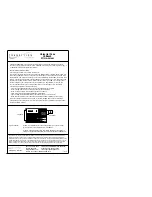
18
TransNET OEM Integration Guide
05-3946A01, Rev. C
6.0 OPERATING PRINCIPLES & SPECIAL CONFIGU-
RATIONS
IMPORTANT:
The following discussion of setup and commands is generic to TransNET ra-
dios and networks. Since it is not known if your network will be made up of
only TransNET OEM transceivers, or a mixture of OEM and standard pack-
aged versions, references to the DATA and INTERFACE ports can be used
interchangeably. The DIAGNOSTIC port is only available on the standard
transceiver and on the Evaluation PCB. For the TransNET OEM, this con-
nection can be made through the Evaluation PCB, or a user-provided connec-
tion.
6.1 Synchronizing Network Units
The Master controls the synchronization for a given network for all modes.
Setting the Master to
SAF ON
broadcasts a command from the Master to all
radio units in the associated network either directly or through an Extension
radio. This command puts
all radios in the entire system
in a special
time-division duplexing mode that alternates between two timeslots. One
time slot is for data communications upstream and the second for downstream
communications.
The Extensions are single radios which serve as bridges between adjacent
sub-network levels. Extensions will undertake a “Remote personality” in one
timeslot, and a “Master personality” in the alternate timeslot and provide
communications with associated Remotes downstream. Extensions behave
like two radios with their data ports tied together, first synchronizing with
their upstream Master during their Remote personality period, and then
providing synchronization signals to dependent Remotes downstream during
their Master personality period.
All Remotes synchronize to a corresponding Master. This can be the “real
Master” (the
MODE M
unit), or it can be a repeater “Extension” that derives
synchronization from the “real Master.”
Payload polls/packets broadcast from the network Master will be repeated to
all levels of the network, either directly to Remotes, or through network
repeaters—the Extension station. The targeted Remote responds to the poll
following the same path back to the Master.
Synchronization Messages
Remotes acquire synchronization and configuration information via
SYNC
messages. They can synchronize to the Master (the
MODE M
unit) or to any
valid Extension (a
MODE X
unit).
The Master will always transmit
SYNC
messages. An Extension will only
start sending
SYNC
messages after synchronization is achieved with its
Master.
The ability to synchronize to a given radio is further qualified by the sender’s
Extended Address (
XADDR
) and by the receiver’s Synchronization Qualifiers
(
XMAP
,
XPRI
, and
XRSSI
).
Содержание TransNET OEM EL806
Страница 12: ...x TransNET OEM Integration Guide 05 3946A01 Rev C ...
Страница 97: ...05 3946A01 Rev C TransNET OEM Integration Guide 85 ...
Страница 98: ...86 TransNET OEM Integration Guide 05 3946A01 Rev C ...
Страница 110: ...GE MDS LLC Rochester NY 14620 General Business 1 585 242 9600 FAX 1 585 242 9620 Web www GEmds com 175 Science Parkway ...
















































